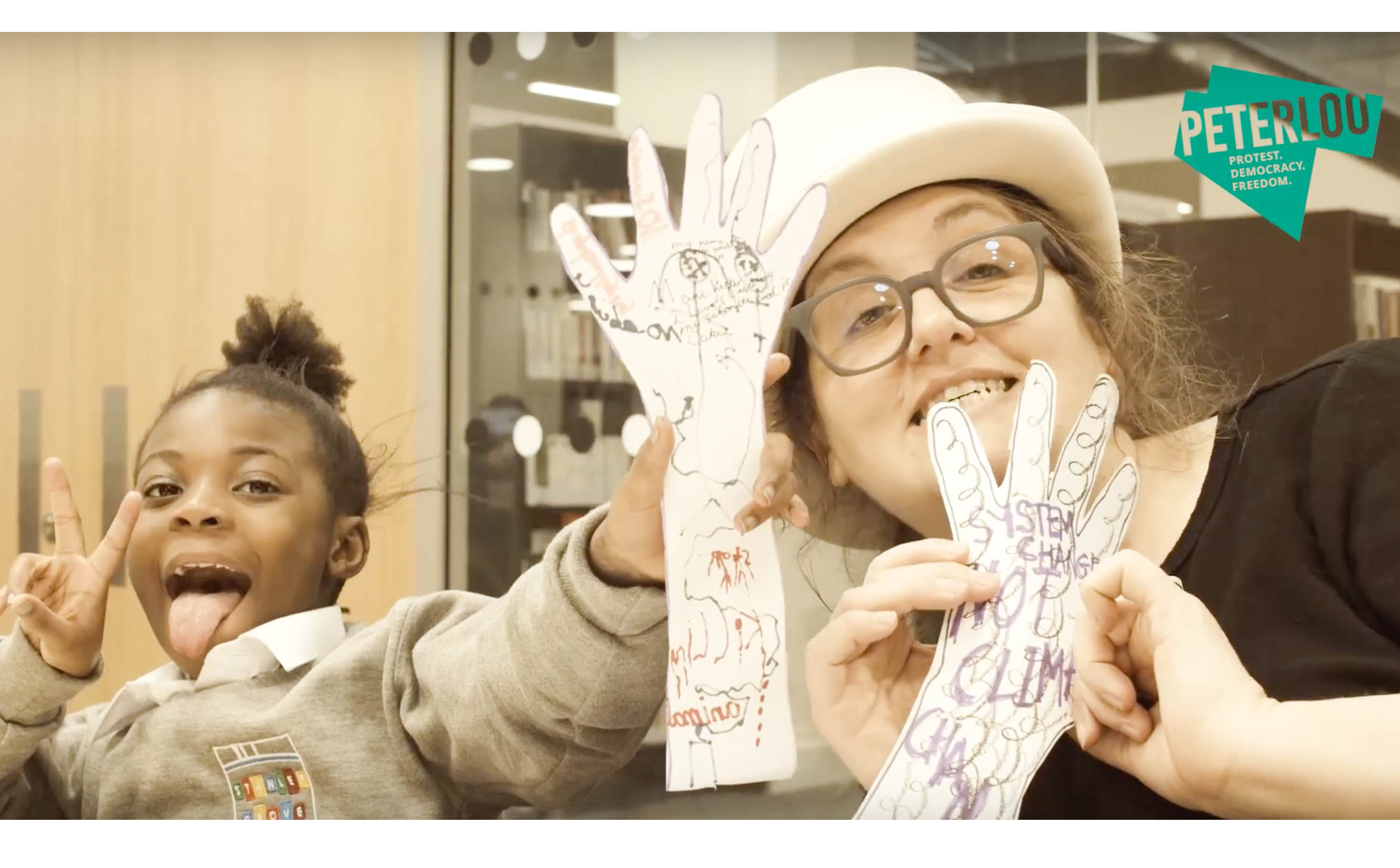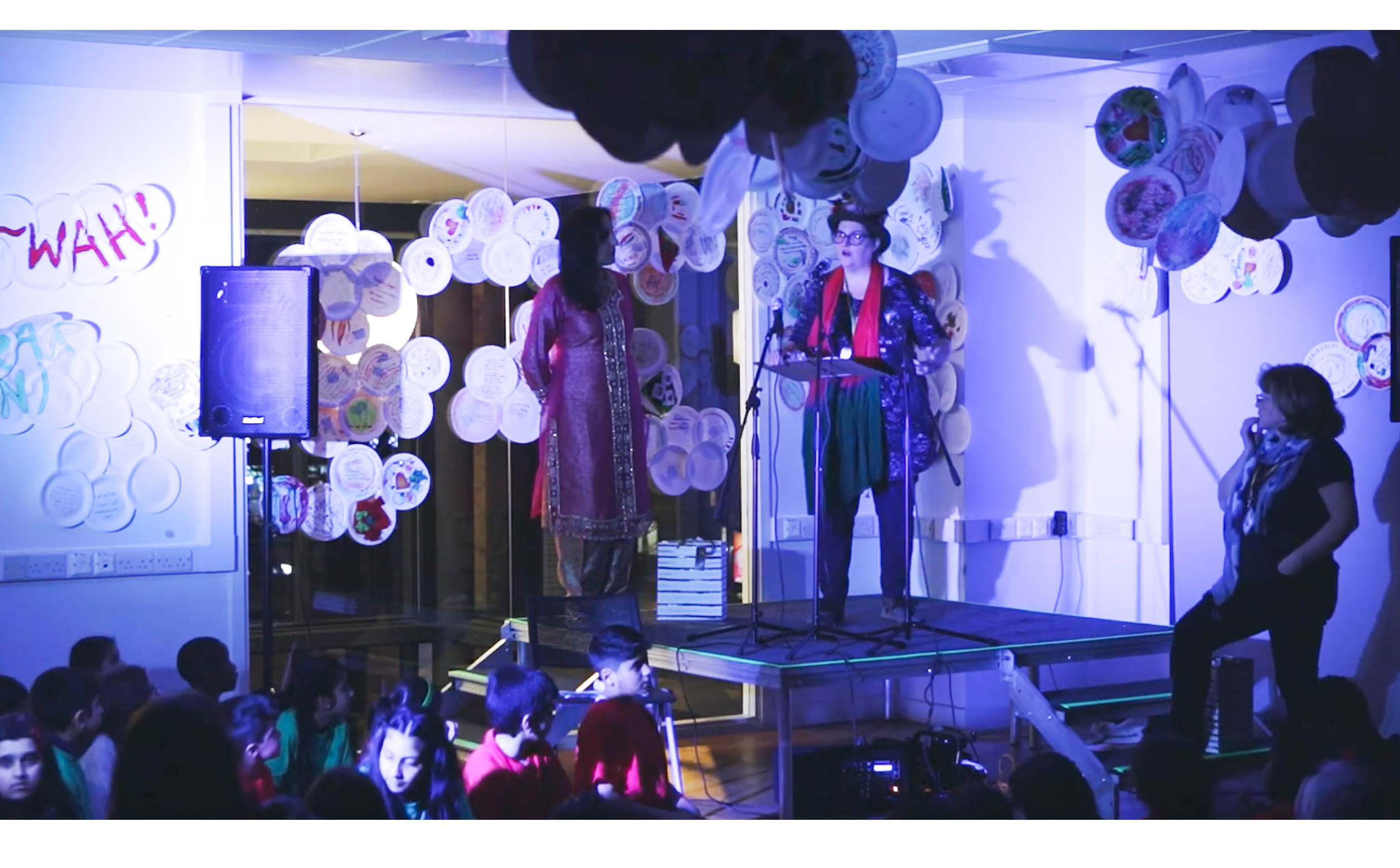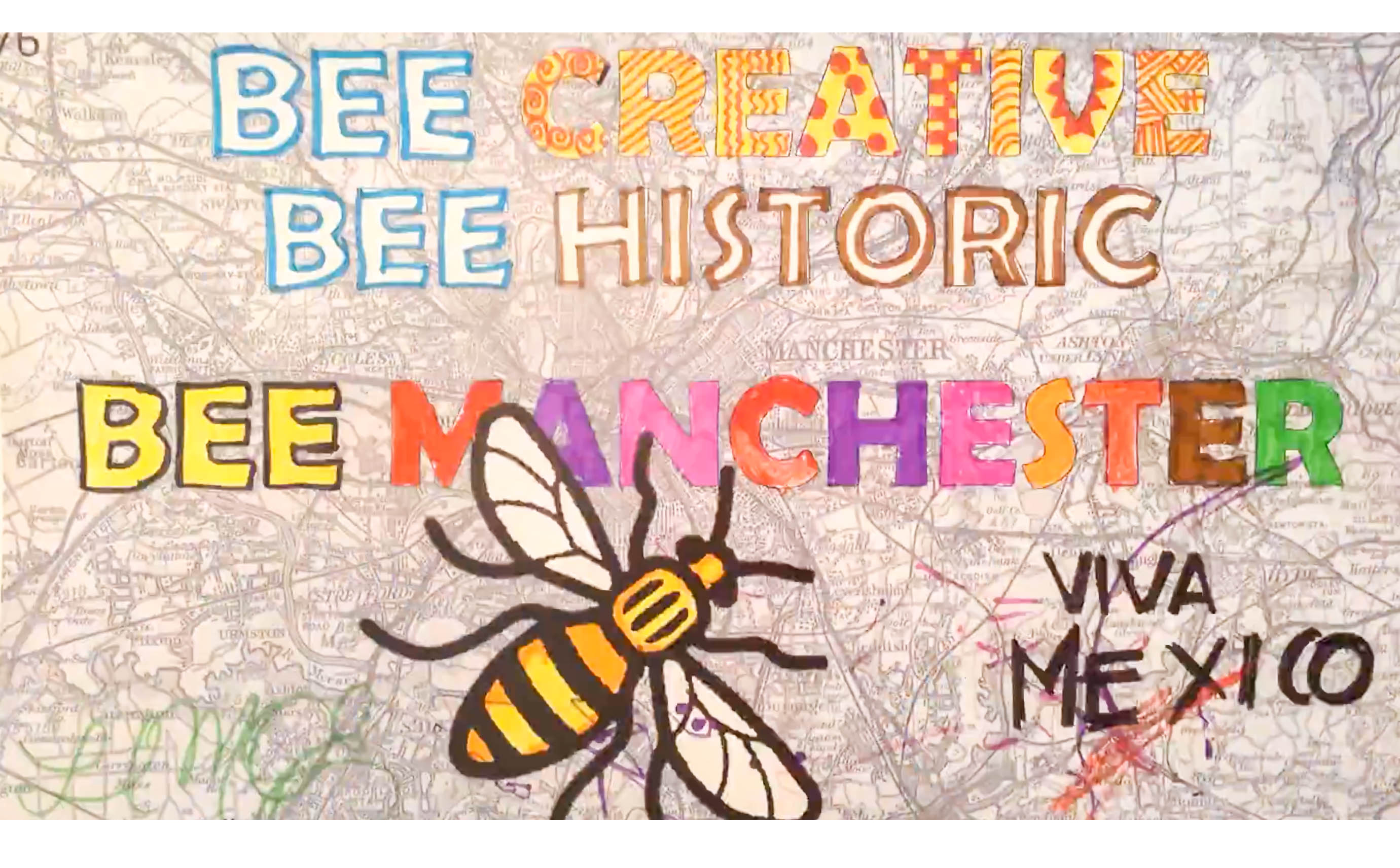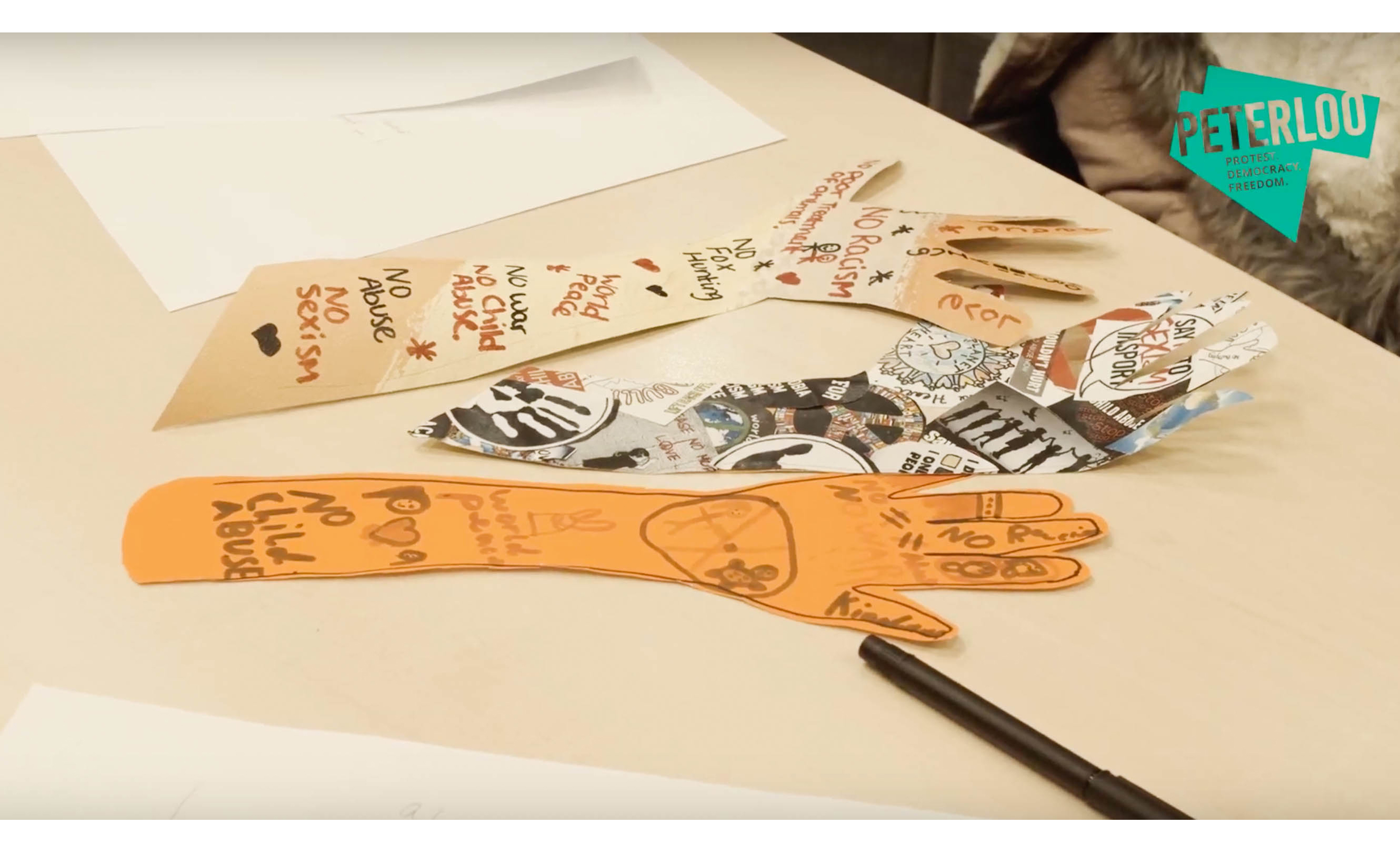Emma Martin is an artist and creative lead based in Manchester who runs a project called Building the Bridge which aims to tackle 'poverty of experience' by creating large-scale art projects. Although she's run Big Draw Festival events for years, she's just joined The Big Draw as our first Schools Ambassador!
We caught up with Emma to hear about her vision for the new role as well as her relationship with the city of Manchester; it's schools, residents, and cultural assets.
"Emma's work has been truly transformational at Stanley Grove. We have also seen it develop through our partnerships with other schools and organisations such as the Whitworth Gallery, Manchester Museum, Jodrell Bank, Libraries, the Museum of Science and Industry, Manchester Book Festival and UNESCO.
The impact of this creative work has also been seen through imaginative curriculum development. Emma’s collaborative and inclusive approach, working alongside staff in schools and developing strong links between families and the rich resources on the doorstep is great for our communities. She has an immense creative talent and a passion for ensuring that children, young people and families see schools as the heart of their community, bringing people together, Bright Futures Educational Trust believes that there’s no more important work than this!"
-
Gary Handforth, Executive Principal, Director of Education, Bright Futures Educational Trust
DT: Thank you for taking the time to speak with me Emma! We are so excited to have you on board as our new School’s Ambassador. Today, we are going to begin by talking about Stanley Grove Primary Academy, the school you’ve been working with. One of the primary markers of their success has been having an artist in residence which is you. Could you tell us a bit more about why they decided to have an artist in residence as that is a bit unusual for most schools?
EM: Well, there are a few schools that do have artists in residence, but that’s not what I do, I’m not an artist in residence in that way. I started off there initially as a mentor for the first year, as I had a big idea I wanted to explore.
DT: Interesting, could you explain more about what your role is there? How it’s different from an artist in residence?
EM: When I started out as a young artist I was working in theatre as well. I loved doing teaching as a part of that and so I decided to go and get my teaching qualifications in art and drama. I then got a job in a secondary school and was really happy as an arts and drama teacher. However, after a few years, I realised that the teaching role I had wasn’t allowing the time I wanted to create my own art. So, eventually I quit to be a community artist and to focus on my art. However, when I was doing that, I missed the educational aspect of my previous roles. I wanted to experiment with the idea of what it would be like to have an artist as a permanent member of staff and as part of the leadership of the school, rather than the artist residency role.
I wanted to be working with children that are younger to have increased impact earlier on. I felt that because I was a secondary school teacher, I needed to have experience also in a primary school setting. I knew it was important to be embedded within the school so that I could understand the rhythms as it’s very different to a secondary school. Therefore, I literally went and applied for five different mentor jobs including a classroom assistant, with the idea that I’ll go and spend a year in any random school and become acquainted with how the primary schools work, and then I would go away, and write a bid and line up with a school....


DT: How did that go? Did you find a job that allowed you to become more acquainted with how primary schools operate?
EM: That was what I was doing at Stanley Grove. I went for a year to fact find and ended up in my dream job. What actually happened was that a new Head Teacher came on board, a very forward-thinking man called Phil Melland. He was interviewing staff to get to know them initially and when we met, I explained that I was leaving, as I had gained what I needed to go away and work out how an artist could have a lead in schools. He responded by asking in a surprised manner, “Why can’t you do that here?” He proceeded to say, “While you are embedded at this school, work out what you need, and what this role is.” So, he sorted it out properly and I was taken on as a permanent, full-time member of staff. He had amazing faith and allowed me the space and time to develop what would be most beneficial for the children and community.

[Emma Martin and the people of Greater Manchester create a large scale pop up installation as part of Peterloo 2019]
DT: That’s incredible support. In this unique role, how did you initially begin to lead the school creatively? What measures did you take?
EM: A lot of schools will employ an artist temporarily, to come and do workshops or short stints, but this was a very different idea. My actual role was “Artist and Creative Lead” and the idea was that I would take the lead on shaping the school’s creative offer. I was getting the leadership to think creatively, not just in terms of art and drama lessons, but as a holistic school approach. A lot of the things I did had to do with science as that’s also a creative subject.
I started off by doing a survey in the playground, seeing where kids were going and what they were doing culturally in and out of school. I initially started off with the question, “Have you ever been to a gallery?” and within minutes, it was evident that nobody had. Then, when I asked if anyone had been to the park 5 minutes away from the school, only 15% of the kids had done that, and only 12% of the kids had been to the city centre which is only a mile from the school. More of our kids have been on an airplane to see family in Pakistan than had been to the city centre. This led me to think about what impact that has for our kids, where Longsight is kind of on an island, separated off from the rest of Manchester really.
DT: Tell us more about your work in Manchester, Longsight in particular where the school is located. I understand this is an area of high social deprivation and limited cultural access. How have you used art to connect the community to culture?
EM: Longsight isn’t connected to the rest of the city with all of the amazing museums, galleries and cultural assets. If they aren’t going into the city centre, they aren’t accessing these resources. That’s when I began “Building the Bridge” and providing access to art to help our children feel connected to the city and its cultural assets. That’s where I took inspiration from The Big Draw. The first year I started the project, we did The Big Draw in October. I’d heard of the festival before and I didn’t have a concrete programme in place, so I thought I’d utilise The Big Draw Festival model. It seemed a fun idea that would engage the children whilst I continued to research and develop project ideas. Then we won The Big Draw Festival Award for Outstanding School! The following year we did The Big Draw again and we tried to widen it out further to include more people. We included another school, and we won again! It was a revelation, realising that we can do high-quality mass participatory artworks as a way of linking children to each other and their city.


DT: Providing access to cultural assets is incredibly important. How did that experience of engaging with culture change the children and families you worked with? Were there perhaps pre-conceived notions or perceptions that you managed to dispel?
EM: I was successful in enabling children to have meaningful experiences within galleries and museums. However, there were a number of challenges associated with the project. I recognised that if I did manage to get a child to a gallery, they might not feel connected to it for various reasons. One major reason being that a lot of the galleries have installation art which might appear foreign as many children might be expecting a standard exhibition with pictures hung in a straight line on the wall. Therefore, I used The Big Draw to make an installation each year so that the children had an experience of conceptual and installation art.

[Manchester Writing School lecturer Anjum Malik was the lead poet at this Longsight Library event, led by Emma Martin ‘Building the Bridge’ and Stanley Grove Primary Academy]
DT: We’ve had lots of great Big Draw Festival events that were based around or resulted in installation art – we love it! How did you manage to do that with your school?
EM: Every year, we do a massive installation work in our school that the children come to visit. I use this occasion to explain to them what a gallery is and to help them feel comfortable in that environment. Offering them new ways of engaging with art and looking at works is so important, and we do that through conversation. “You don’t touch the things, you use your eyes”, “There are signs on the wall, you can read them to get more information, if you like”, were some of the ways that we introduced children to the concept of visiting a gallery space and interpreting the artworks. That way, we were teaching them about what a gallery is by having one in the school. Their parents would come along, it was great. It was scaffolding the idea of visiting galleries and museums. “Building the Bridge”, the project I run for the school, makes up about 50% of my workload. The project is based around the idea of getting kids into museums, galleries and cultural assets. However, the other model we use is that we get the museums and galleries to come to Longsight so that they become a familiar place and face for the children to connect with. These experiences provide them with a sense of cultural ownership; this is something for them.
DT: It’s terrific that you’ve developed these two models and have involved the wonderful museum and galleries in Manchester as well. Can you speak more about that partnership?
EM: The demographic of the children in Longsight are deemed “hard to reach” in that they aren’t white middle-class kids, the children that are typically most likely to regularly enjoy cultural experiences. Museums and galleries need to widen participation, and we are eager for our children to have these meaningful and enriching experiences. The year we had disappointing SATs results the children had to write about going to a beach, but only about 11% of the children had actually been to a beach. They were meant to be writing about being on a beach having never taken their shoes and socks off on a beach. Therefore, it was really easy to argue that unless our children have wider cultural capital, and wider experiences, how are they going to write with an efficiency? How are they going to link to the curriculum? How are they going to have aspirations or ideas about what they can be in the future? It truly became a partnership between us and the museums and galleries in Manchester once the impact and potential of the project was realised. It’s been inspiring to experience the openness of these institutions to welcome in our children and project. We started working with just Manchester Museum, Whitworth and Jodrell Bank, who have been incredible, but now we work with as many as we can. Our last Big Draw project was with ten of Manchester’s cultural assets.

DT: Manchester has a history of social activism. What is it about the city that makes it such a ripe ground for bold change?
EM: In Manchester we have a saying by Tony Wilson, “Manchester, we do things different here”. It is a real catchphrase that people use and can be quite trite, but I think we do. Manchester is a wonderfully creative city, there is a rich heritage in this region for cultural trailblazing. We’ve got a strong track-record for standing up for people’s rights and seeing the power of change in Manchester. I believe, it’s a place that’s second only to London in terms of cultural output. It should be an integral part of our children’s lives. It’s part of the future of the city, of their employability, of their mental health, and feeling connected to their own city.
Longsight is an area of Manchester with high social deprivation. There was a study done in 2016 about social mobility, and three of the ways in which social mobility has deteriorated in the past 30 years is regarding families spending quality time together, visiting museums and galleries, and having books in the home. For these reasons, it’s crucial that all of my projects involve those three things: Families having fun together, families visiting together and families reading and enjoying literature together.
I’m not a Mancunian myself, I’ve been adopted the city as I’ve lived here for twenty years. For me my work combines all of my passions simultaneously - as artist, educator and community champion. Seeing creativity blossom by watching children develop from nursery and reception is what the project is all about. I wholly believe in fighting for a better society - this work is my way of helping realise this. All children should have equal access to these opportunities as creativity is innate in all of us. It shouldn’t just be that the kids who go to lovely schools in the posh leafy areas, are the ones that have access to art, music, dance and theatre etc...
Today I’ve literally spent all day delivering art materials all across Manchester for a project. I visited Wythenshawe, an area of high deprivation to take art materials to a school there that are involved in our project. Next I visited Cheetham Hill. Both of these place mirror Longsight in sharing similar issues and challenges. Myself and the rest of the leadership team at the school that I work for feel we have a social responsibility to share this learning and offer this model to other schools that don’t have this unique opportunity. Longsight is amazing, but it not unique. A lot of people are missing out on these things because of a lack of social mobility and access to these places.
In Longsight, we have an amazing library with a wonderful team. They collaborate with us frequently, sharing their lovely space in support of our events. We don’t just put events on in our school, we also run them in the library because we don’t want people thinking they are just for young people. We showcase everything there so it’s open to the whole community. Longsight is wonderful; I love it, truly. The families have really got behind us, the kids just grab any opportunity you give them. They are desperate for experiences, and to meet new people. I want to get to a point where they accept that it’s normal to have these experiences because all kids deserve these opportunities.

[Emma Martin and the people of Greater Manchester create a large scale pop up installation as part of Peterloo 2019]
DT: I was so impressed with Manchester when I visited. I fell in love with the galleries. Manchester Museum was my favourite.
EM: The Whitworth and Manchester Museum are my favourite too! Last year we worked with 45 schools. In 2019, we once again partnered with The Big Draw linking in 29 schools and reaching 10,000 young people. We installed their work in 10 different museums and cultural asset This just demonstrates the potential for linking schools and institutions together as co-creators. Often, the education system can be seen as overly encouraging competition amongst schools, but also cultural assets ‘competing for audiences’. We are trying to break down those barriers to collaborate and make art together to see our city and education system as a whole. The project is about connecting children to the city and schools to one another.
DT: That’s incredible. Now, moving onto the big news! How do you feel about becoming a Big Draw Schools Ambassador?
EM: It’s a massive honour for something that grew so much out of the Big Draw, it’s a really lovely thing to feel that I can give back in some way. We’ve got a number of interesting models that we’ve had time to develop. Very few places have the opportunity to think about what works and what’s needed. It’s brilliant to have the time and the space to develop these ideas, to eventually introduce this model to other places; this is how to connect schools and children together. To connect families to cultural assets. My ambition for becoming a Big Draw Ambassador is realising that there are cities beyond that could benefit from what we’ve worked out and developed. I feel that being a Big Draw Ambassador can be instrumental in building those bridges and helping spread the availability of cultural experiences. It’s a big honour and lovely to be recognised for the work that we’ve done. It’s nice to have that golden thread running through it, to have started with The Big Draw and then to realise that yes, this does have legs on it, it works. In year one of Building the Bridge, it was just for our children only. We are now in year five of the project and had over 35,000 participants in that year alone. The reason we can punch above our weight like that is because we have really refined the models, but also recognition needs to be given to my amazing assistant Judy Lyons. She started out as a mum-volunteer, supporting my projects because her kids came to the school and she was excited by what we are trying to do. The school recognised her worth and she was taken on as my fulltime assistant. And my God, that woman works hard! Nothing would happen without Judy slogging away behind the scenes. I’m massively grateful to her and all the other Stanley Grove staff members, ex-pupils and parents who volunteer their time. Oh, and my family! Everyone at home pitches in – I call it ‘volunteering’ but they are kind of obliged! They are all amazing.
DT: We are so pleased to have you join us as The Big Draw Schools Ambassador Emma. We can’t wait to see what you do in your role! Watch this space...


Interview: Devon Turner in conversation with Emma Martin